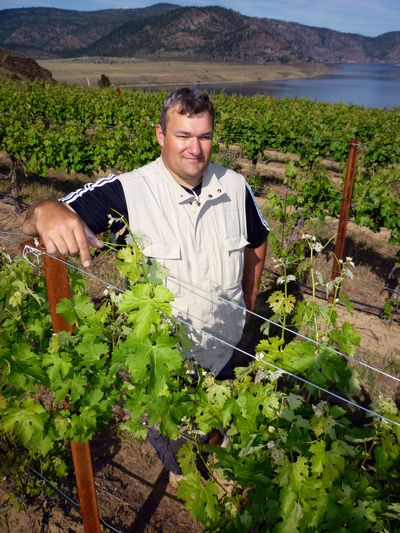Haigs embrace view from Whitestone

Twenty years ago, Walter and Judy Haig were entertaining friends on the deck of their Lake Roosevelt summer home when the conversation turned to the history of their 1,000-acre property.
The previous owners had passed along the original homesteader’s scrapbook, which included an old U.S. Department of Agriculture map identifying what crops were planted in the area at the turn of the previous century. To everyone’s surprise, wine grapes were highlighted on the land where they sat.
Soon afterward, the Haigs contacted Washington State University viticulture expert Robert Wample and set out on a journey to grow grapes and make fine wine. They named their vineyard and winery after nearby Whitestone Rock, a granite landmark rising 800 feet above Lake Roosevelt 16 miles north of Creston, Wash.
Their son, Michael, was a teenager when the journey began, and as the grapevines grew and matured, so did Michael Haig’s passion for the wine industry. He’d planned to get a degree in winemaking, but his mentors persuaded him he had enough on-the-job training and connections in the industry, and that a better choice would be a degree in business, “because the biggest reason wineries fail is they don’t know how to do their own books,” he said.
Michael Haig now runs the vineyard and is head winemaker.
On Aug. 25, the public is invited to visit the remote vineyard and enjoy barbecue, live music and, of course, Whitestone wines. For more information and tickets, contact Whitestone’s Spokane tasting room at (509) 838-2427.
Haig discussed Whitestone’s evolution during a recent interview in his vineyard.
S-R: What was your first job in the family business?
Haig: When I was 16, WSU gave my parents paper gauges to record the high and low temperatures for seven days. The winter of ’92 was one of the worst ever, and each week I had to hike up here through knee-deep snow to change out those temperature gauges.
S-R: When your parents bought this old homestead in 1989, did they intend to grow anything?
Haig: No, it was just a beautiful chunk of land populated by snakes, bighorn sheep, moose, coyote, cougars and badgers. And deer, which is why we have an 8-foot fence around the vineyard.
S-R: How did they decide where to plant vines?
Haig: WSU’s viticulture department looked at the soil, the wind flow, and the orientation – you want to plant on a southern-facing slope, the vines running in a true north-south alignment for the most sun.
S-R: You’re located pretty far north, compared with Washington’s better known grape-growing regions. What’s your microclimate’s secret?
Haig: We’re surrounded on three sides by this giant body of cool water. In the summertime, we always get a nice breeze that keeps our vineyard cool. In September, we go from being one of the coolest vineyards in the state to the warmest. Most years, we can keep our leaves almost until Thanksgiving. Our climate is closer to Napa and Bordeaux than it is to Walla Walla and Yakima. So we produce more balanced, Old World-style grapes.
S-R: Did WSU essentially adopt you?
Haig: Yes, because in the early 1970s, Walter Clore, the father of Washington state’s wine industry, did a survey and pegged this area as one of the best for growing wine grapes. In ’92, when my parents went down to Pullman, WSU was excited to put in a full-scale vineyard to test Clore’s research.
S-R: Are there any other commercial vineyards nearby?
Haig: I think you’d have to go almost 100 miles to find another.
S-R: But you’ve done well. Why aren’t there more?
Haig: We’re one of the only sites on the “wrong” side of Lake Roosevelt that has a south-facing slope. My viticulture friends drool over the bench right across the lake from us. But that’s reservation land, and the Colville Indian Tribe has had no interest in planting vineyards.
S-R: How did you learn viticulture and winemaking?
Haig: For the first decade, we sold our grapes to Walla Walla wineries. I would deliver the grapes, then assist the winemakers with harvest. And for years I went down to WSU’s research center in Prosser and learned about viticulture from Bob Wample. I also took winemaking courses at UC (University of California) Davis.
S-R: What are the advantages and disadvantages to being so remote?
Haig: The advantage is that if you like my vineyard’s flavor profile, this is the only place you can get it. The disadvantage is that I’m out here by myself. So when my mildew sprayer broke earlier this year, I spent a lot of time trying to get a replacement. If I were in Walla Walla, I could have called my next-door neighbor and said, “Can I borrow your sprayer today?”
S-R: Was the winery successful right away?
Haig: It takes a while. I was lucky that my parents financed it instead of a bank. I didn’t have to make decisions such as producing a white wine because bankers don’t want to wait two or three years while your reds age to see a return on investment. We’re on pace to pay off the entire winery and vineyard debt this year.
S-R: What are you most proud of?
Haig: The fact that we’ve stuck to our mission, which is to create a time capsule of a specific place at a specific time, using only grapes we grow ourselves.
S-R: What do you like most about your job?
Haig: My time in the vineyard. The older I grow, the more I want to be outside.
S-R: What do you like least?
Haig: The rattlesnakes.